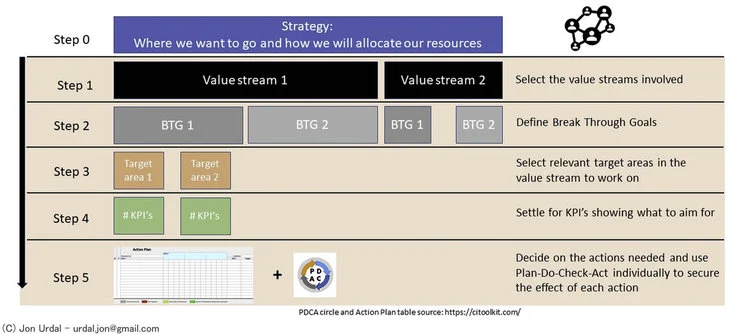Successful strategy work is difficult, and many companies and organizations struggle with this. Either because developing the strategy itself is difficult in itself, or because they fail to realize it in practice. I would therefore like to share some experiences on how to achieve greater success with - and impact from - strategy work. These experiences consist partly of having a working model that is easy to communicate and work together on, and partly of being aware of how important your own leadership behavior is for achieving results. The latter is often the most difficult.
By: Jon Urdal
There are many views on what is meant by strategy execution. A minimum common multiple that most people can agree on is that "strategy execution" can be described in two parts: Part 1 consists of planning the necessary activities to realize the strategy and allocating resources for execution. Part 2 is "simply" executing the plan successfully. This part is almost always the most demanding.
Successful strategy work should be easy
Is it that simple? Yes, it can actually be. My experiences, including as head of production at Egmont in Norway, Schibsted's printing plants and as head of environments that develop digital products, have taught me a lot. For example, that successful strategy work is all about management's ability to involve employees and give colleagues room to maneuver and responsibility. Of course, I also use this in my current management job. This way, strategy is de-risked, ownership is created and enthusiasm is generated. To achieve this, we need a model to work with that is as easy to communicate as it is to agree on in practical work.
I use a model that, in my view, is absolutely unbeatable. This is largely because it encourages collaboration in the implementation, provides ownership and thus lasting effects of the strategy work. The model draws on two key areas from the Lean philosophy: value streams (i.e. activities and the interaction between them required to deliver a service or product) and a step-by-step implementation model based on Hoshin Kanri. If you follow the steps in this model, you'll be well on your way to successful strategy work.
Read also: Everyone deserves a great leader!
A useful model for strategy work
To succeed with strategy work, we work in the following way: The starting point is that the business has formulated an operational strategy that will give direction and content to necessary changes and improvements, for example by improving existing products and services, or innovating new ones.

Strategy implementation model
Model for strategy implementation
- Step 1: Identify the value streams affected by the strategy. There may be significant improvements or changes, or simply a need for new products and services with associated new value streams.
- Step 2: Define ambitious goals for how to significantly improve value streams.
- Step 3: Identify the focus areas in the affected value streams that we will work on to achieve the goals defined in step 2.
- Step 4: Define KPIs that show how we can see that we are working in the right direction by measuring what we do.
- Step 5: Identify activities to be completed in each focus area. If you are familiar with "Plan, Do, Check, Act", use this for each of the activities.
Remember to involve employees in the strategy process
With these five steps, we have a simple model to rally around, which provides a clear focus on how we work practically with the direction from the strategy. At the same time, and perhaps even more importantly, is management's ability to actually involve employees and create good teams in the implementation. Without the right leadership skills, this too will be another model that ends up on the shelf.
If you do this correctly, you will succeed with strategy work, like me, and gain many good experiences and results. Try it yourself!

